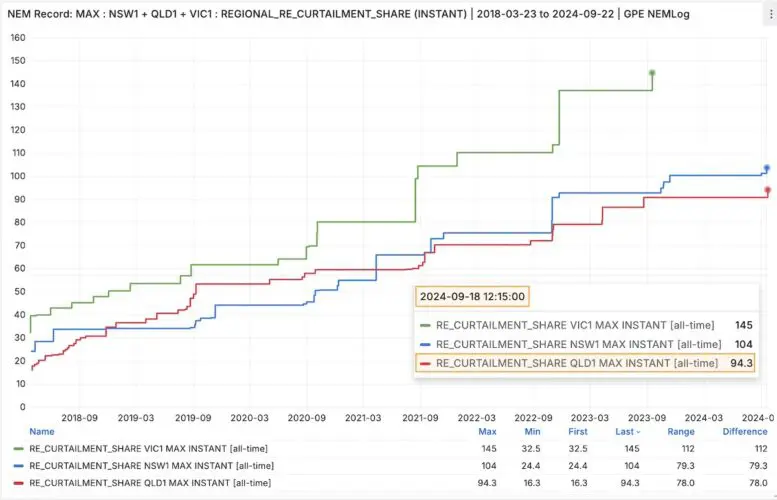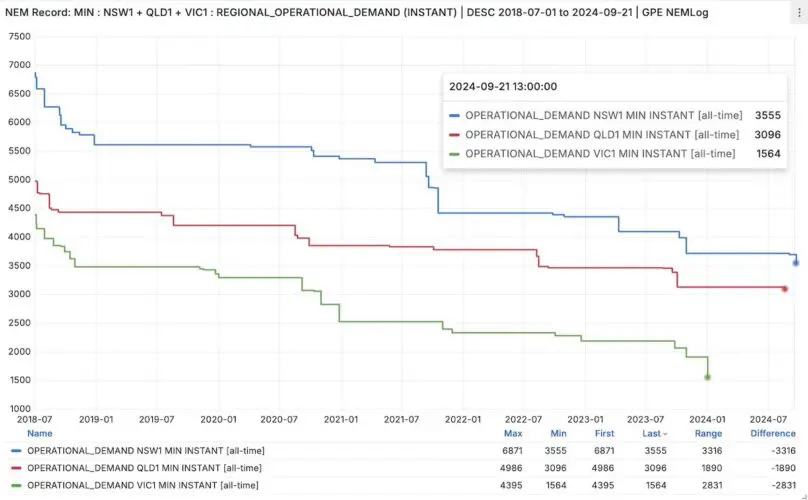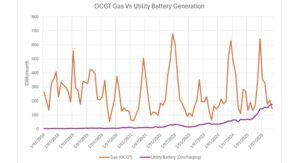Renewable energy records continue to fall across the National Electricity Market (NEM), including a new high for rooftop solar in New South Wales on the weekend and, in Queensland, a new peak for the potential amount of renewables in the state, factoring in curtailed solar and wind.
First to Queensland, where on Saturday September 21 renewable energy plus renewable curtailment reached a new high of 7,450.7 MW at 13:20, up 31.95 MW from the previous record of 7,418.8 MW on 29th December 2023.
According to Geoff Eldridge from Global Power Energy, this was followed by a new maximum instantaneous share of renewables (including curtailment) of 94.3% at 13:05 hrs on Sunday September 22, up 3.35% from previous of 90.9 % back in August 2023.
On the way to this record, the state achieved a new low dispatch price for wholesale electricity, when prices plunged into the negative to -801.1$/MWh at 11:35am, a 712.77 $/MWh decrease on the previous record of -88.3 $/MWh on September 03, 2024.

Source: GPE NEMLog
Renewables also helped to push Queensland’s minimum instantaneous native demand to a new low of 4,480.2 MW at 8:00am on Sunday morning, down 209.68 MW from previous of 4,689.9 MW, also recorded on a Sunday morning, earlier this month.
The Sunshine state also notched up a new high for instantaneous renewables curtailment of 2,416.6 MW at 13:15 on Sunday, up from 2,311.9 MW recorded more than a year ago at 1pm on a Saturday.
In New South Wales, meanwhile, GPE NEMLog recorded a record high share of rooftop solar for the state of 53.4% at 12:30pm on Saturday September 21, just a small increase from the previous high of 52.8% set a few days earlier on September 18.

Source: GPE NEMLog
Also recorded was a new low for operational demand in the state of 3,555MW at 1pm on Saturday, down 141MW from the previous record of 3,696.MW on September 01, 2024.
Eldridge says the new records across NSW and Queensland highlight the ongoing changes in demand patterns and renewable energy dynamics for both states, as they move away from coal and try to manage increasing shares of renewables.
“These records reflect the ongoing impact of increased renewable generation in the NEM,” Eldridge writes on LinkedIn.
“As the energy transition continues, understanding and adapting to these evolving trends remains essential for maintaining a reliable and sustainable grid.”
This was the message from a major global report published last week by the International Energy Agency, which said Australia was heading into Phase 4 of renewable energy integration, where it will face “key operational challenges” to the way the power system responds to maintain stability immediately following disruptions in supply or demand.
“By 2028 the main case of our renewables forecast shows that a range of countries …reach unprecedented annual shares of generation originating from wind and solar power plants – some above 65%,” the report says.
“This development calls for a better understanding of how this could affect electricity systems even further, and what measures can be taken on several fronts to ensure that those higher levels of VRE are integrated in an affordable and secure manner.”








